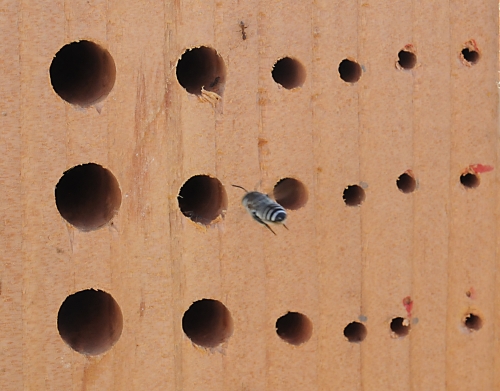I ran into two members of the U.S. Customs and Border Protection Patrol this afternoon.
No, I wasn't at a border. I was merely walking the halls of the UC Davis Department of Entomology. The border patrol agents were there to meet with entomology...

Mediterranean Fruit Fly
MEDFLY--Border patrol agents suspect that travelers to Hawaii may be bringing back mangoes infested with the larvae of a Mediterranean fruit fly. The Medfly can infest more than 260 types of fruits and vegetables, causing severe impacts on California agricultural exports and backyard gardens, according to the California Department of Food and Agriculture (CDFA). The CDFA announced Dec. 2 that it has established a 107 square-mile quarantine zone in the El Cajon area of San Diego County, following the detection of a Medfly infestation.
Posted on
Monday, December 1, 2008 at
5:52 PM
If you're interested in insects--the good, the bad and the ugly--don't miss the Northern California Entomology Society meeting on Thursday, Nov. 6 in Contra Costa County.
You don't have to be a member. No one is going to ask you "What are you doing...

The Good
THE GOOD--A leafcutter bee heads toward a bee block or "bee condo" erected by a Yolo County farmer to attract native pollinators. UC Berkeley professor Gordon Frankie is scheduled to discuss "Native California Bees Looking for Cheap Urban Real Estate” at the Northern California Entomology Society meeting on Nov. 6 in Concord. (Photo by Kathy Keatley Garvey)

The Bad
THE BAD--This is the light brown apple moth, a male. The CDFA's William Roltsch will discuss "Biocontrol of Light Brown Apple Moth, a Quarantine Pest in California” at the Northern California Entomology Society meeting on Nov. 6 in Concord. (Photo courtesy of David Williams, principal scientist, Perennial Horticulture, Department of Primary Industries, Victoria, Australia.)

The Ugly
THE UGLY--The invasive Asian citrus psyllid will be discussed by the CDFA's Kris Godfrey at the Northern California Entomology Society meeting on Nov. 6 in Concord. Description from the CDFA site: "The head is light brown. The wings are broadest in the apical half, mottled and with a dark brown band extending around the periphery of the outer half of the wing. The insect is covered with a whitish waxy secretion, making it appear dusty." (Illustration courtesy of CDFA)
Posted on
Thursday, October 23, 2008 at
3:29 PM




